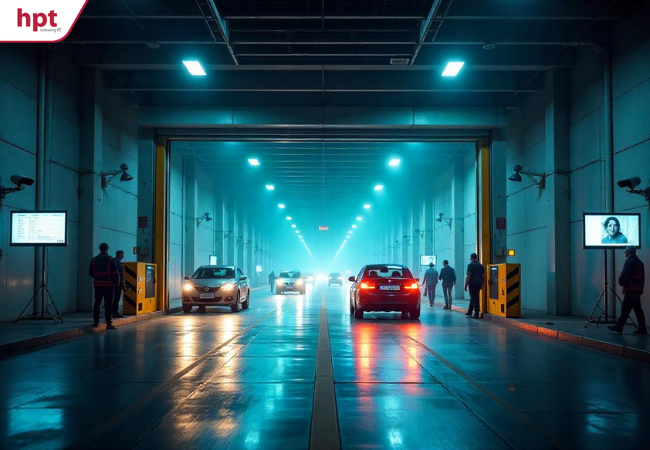The inevitable trend of security management in the digital age
In the process of digital transformation, the demand to build smart cities and manage industrial parks efficiently is becoming a top priority. With the continuous increase in the number of surveillance cameras, government agencies and businesses need a centralized camera management solution (VMS - Video Management System) to:
- Synchronize data from multiple camera sources.
- Perform intelligent analysis using AI and Big Data technologies.
- Control comprehensive security on a large scale, enhancing crime prevention and ensuring the safety of people and property.

What is a centralized camera management solution (VMS)?
Centralized camera management solution (VMS) enables the connection, monitoring, and operation of all cameras on a single platform. Instead of operating cameras separately, this system will:
- Integrate multiple devices and protocols: Supports most models of IP cameras, analog converters, AI cameras, and more.
- Provide unified management through a main interface: Users can check camera statuses,…
- Integrate AI-powered image analytics: Detect intrusions, trigger alerts, count people, and recognize license plates and faces,...
- Ensure high-level security: Data is encrypted, and users are assigned specific permissions.
VMS applications in smart cities & industrial parks
- Traffic monitoring and urban security: Identify violations, detect congestion, and analyze vehicle flow in real time; support law enforcement in quickly detecting and addressing theft and disturbances.
- Urban infrastructure management: Monitor environmental conditions, oversee public areas, and provide databases for urban planning; integrate early warnings for natural disasters, fires and explosions.
- Enhancing safety in industrial parks: Control warehouses, entry and exit gates, and hazardous areas; monitor compliance with safety regulations; reduce security personnel; and support integration with access control systems.
Core benefits of centralized camera management solution (VMS)
- Centralized management and optimized resources: All video data is collected at a central operations hub, helping businesses and local authorities reduce operational costs, save time, and minimize workforce requirements compared to managing cameras separately.
- Intelligent image analysis: AI-powered technology enables facial recognition, license plate detection, and intrusion alerts with high accuracy and quickness.
- Instant alerts, rapid response: The VMS system immediately sends notifications to mobile devices or monitoring screens upon detecting incidents, allowing security teams to take swift action and mitigate risks.
- Data security: Data is encrypted during storage and transmission. Access rights are clearly defined, ensuring security and preventing data breaches.
- Flexible integration capabilities: Easily expand with additional cameras, sensors, and integrations with IoT, Big Data, GIS systems without requiring major infrastructure changes.
Criteria for selecting VMS solution provider
Choosing the right VMS solution provider not only optimizes surveillance operations but also ensures scalability and seamless integration with existing systems. Below are some important criteria to consider:
1. Scalability and integration capability
- The VMS system should support integration with various types of cameras, sensors, and other management platforms such as SCADA, AI, or existing security surveillance systems.
- It should support diverse connection protocols such as ONVIF and RTSP, facilitating easy expansion when needed.
2. High performance and stability
- The system must be capable of processing large volumes of video data with low latency, ensuring crisp, smooth imagery.
- The system should operate reliably 24/7 and include backup and redundancy mechanisms to avoid interruptions.
3. Intelligent management capabilities
- The solution should integrate AI for image recognition, analysis, and detection of abnormal events.
- It should allow for real-time alert configuration to enhance surveillance effectiveness.
4. Data security and privacy
- The system must support video data encryption and multi-factor user authentication to prevent unauthorized access.
- It should comply with security standards such as GDPR and ISO 27001 to ensure data safety.
5. Cost-effectiveness and technical support
- A balanced approach is required between the initial investment and long-term operational costs.
- The provider should offer prompt, professional technical support, with a dedicated team ready to resolve issues as they arise..
The centralized camera management system (VMS) just not only monitor images, it also paves the way for comprehensive digital transformation in smart cities and industrial parks. By integrating AI, Big Data, and IoT technologies, the VMS enhances security quality, saves costs, optimizes operations, and brings tangible benefits to both communities and businesses.
To meet the growing market demand, HPT provides AI-based camera management and intelligent image analysis solution. This solution not only effectively meets surveillance and security control needs but also offers in-depth video and image analysis through artificial intelligence to support a range of applications, such as time and attendance tracking, roll calls, traffic safety, workplace safety, fire and smoke alerts, …
If you would like to learn more about VMS solution, please contact HPT now!